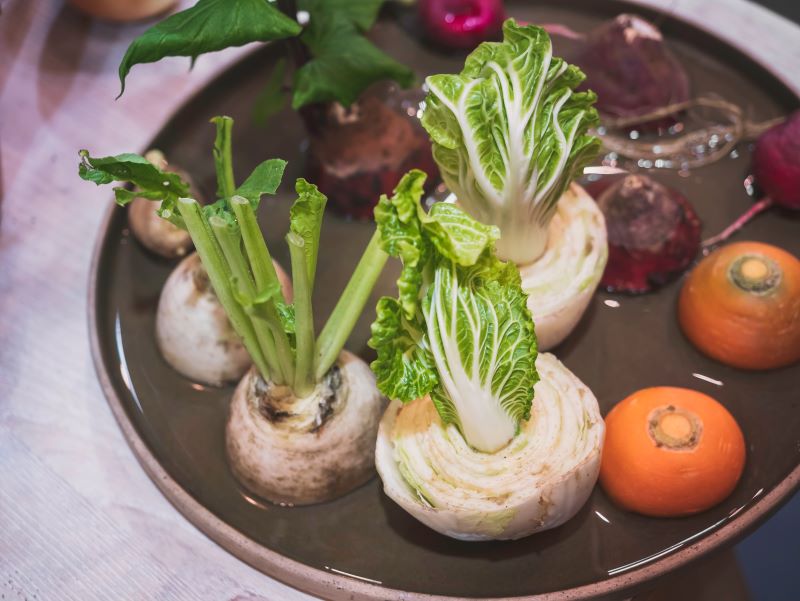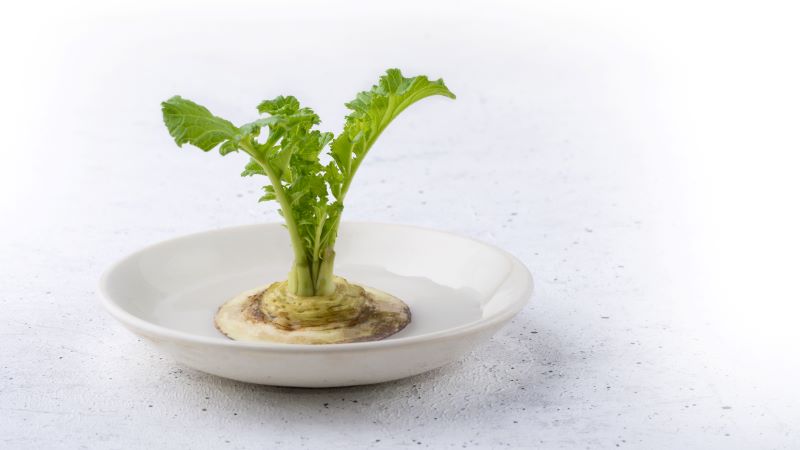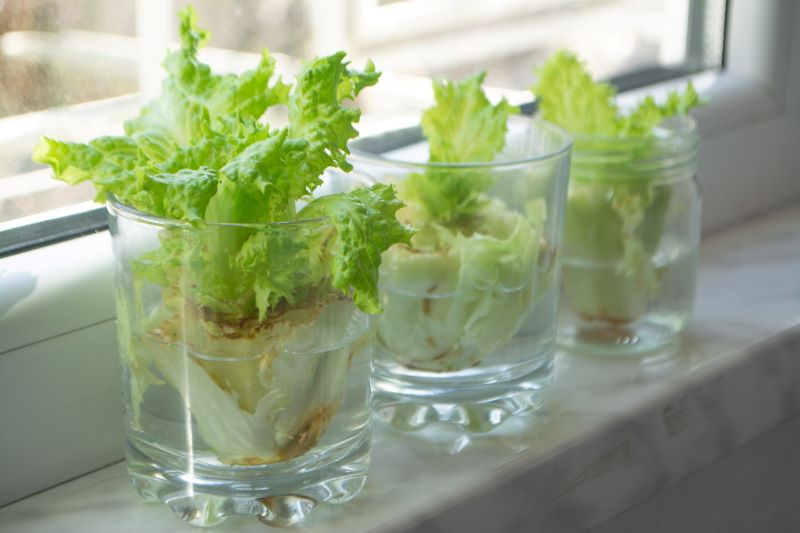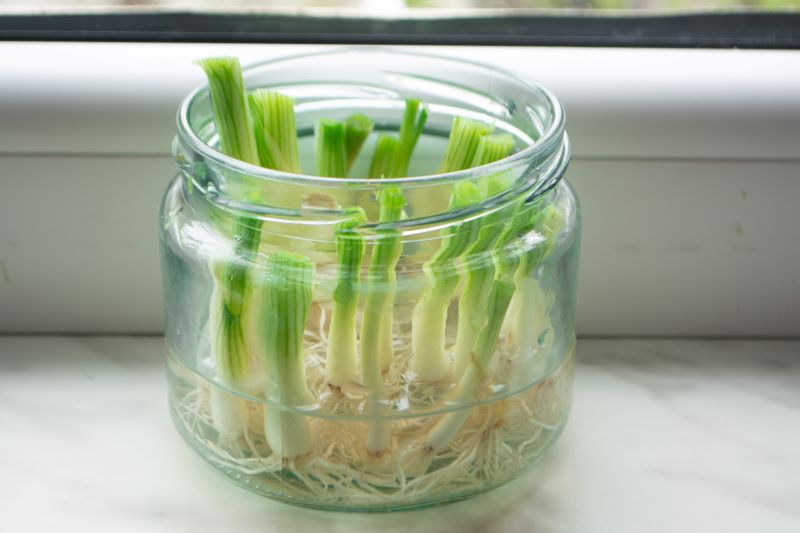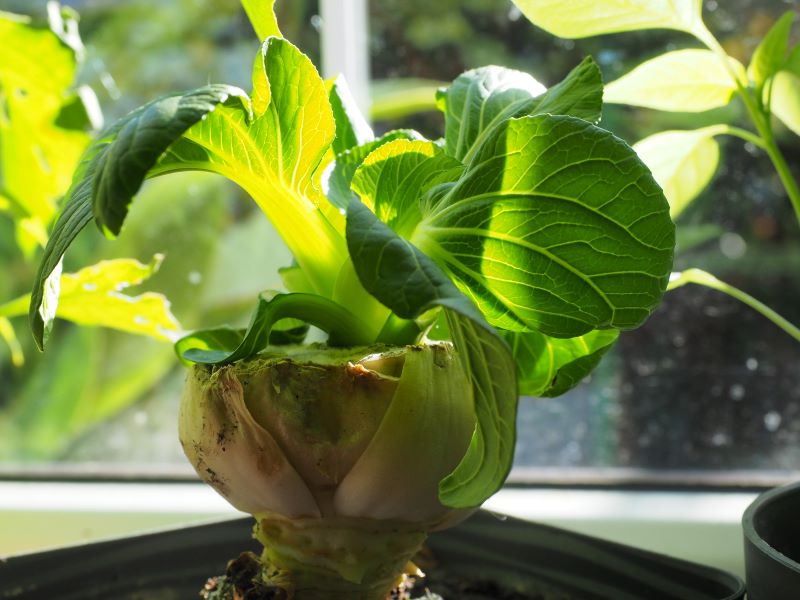Calling all veg growers, money savers, and parents looking for ways to keep young children busy and entertained. We’ve got just the trick for you.
Did you know you can regrow vegetables from scraps. It’s really rewarding and an easy way to:
- Reuse and recycle what you normally put in the food waste into another meal.
- Save money on the weekly food shop.
- Save money on buying seeds and vegetable plant plugs.
- Grow a steady supply of fresh treats for pet bunnies and guinea pigs.
- Have a bit of fun while experimenting with what to grow.
- Teach kids about the lifecycle of plants and the importance of sustainability.
So, save your kitchen scraps (they’re going to be your next meal!)
All you need to get started is:
- A sharp knife
- A shallow dish or jar
- Fresh water
- A bright sunny windowsill (or greenhouse).
And scraps from any of these easy to grow veg.
- Carrots, beetroot, turnips, parsnips and other root crops
- Celery
- Bulb fennel
- Lettuce, pak choi and other leafy greens
- Onions, garlic, leeks and shallots
- Basil, mint or other herbs
- Potatoes
- Sweet potatoes
Here’s how to do it.
1. Carrots, beetroot, turnips and other root veg
Use the cut off top of a carrot, beetroot or other root vegetable (the bit where the leaves and stems join the root).
Then take this veg top and place in a shallow dish of water. You don’t want to completely cover the top – just enough to keep the flat bottom wet.
Within days you’ll see fresh green tops starting to grow again.
In the case of beetroot, you can harvest these fresh new leaves and eat them in a salad. Or use the highly nutritious carrot leaves (they taste a bit like parsley) in something like a pesto or a chimichurri.
If you leave the roots to grow, you can even transplant the tops back into soil for a longer harvest.
2. Celery
To regrow celery, simply cut off the bottom from a celery leaving you with the sticks for a meal. Then place the leftover celery base in a shallow container with a little water (enough to cover the bottom of the celery base).
Keep this container and the celery in a sunny and warm place (a sunny windowsill is perfect).
New leaves and stalks will start to grow within a week or so.
Wait and harvest these as needed. Or plant into soil to allow it to grow into a full-grown plant.
3. Bulb fennel
Bulb fennel (Florence fennel) can also be regrown in the same way as celery.
Save the base (with root system intact). Place this in a container with shallow water and give it plenty of light and warmth.
When you see new green shoots emerging from the middle of the base you can plant it in soil.
4. Lettuce or pak choi
When using a head of lettuce or pak choi take the trimmed off base (with the root section intact) and stand in some fresh water. Using something like a clean jam jar is good for this.
Give it water and sunlight and within a couple of weeks you’ll see fresh new growth you can use as a cut and come again crop for salads.
Or, once the roots and fresh green growth are present, you can also transplant into soil to grow a larger plant.
5. Basil, mint and other fresh herbs
Regrowing your supermarket herbs is a great way to ensure a consistent crop.
All you need to do is take a stem and pick off most leaves allowing a couple to remain at the top. Place the stem in a clean jar or glass of water, making sure the leaves are well above the top of the water.
In just a few days you’ll start to see roots starting to grow from the submerged part of the stem. As soon as these roots are growing healthily, plant these rooted stems into a pot of soil and grow on your windowsill.
6. Onions, shallots, spring onions, leeks and garlic
Good news if you’re a fan of alliums. They are all a cinch to grow from scraps.
Simply cut off the base of the onion, spring onion, leek or garlic clove making sure it has roots attached.
And as with regrowing other veg, place these cut off bits root side down in a shallow dish of water. Remembering the cut side needs to be above the water.
Fairly soon you’ll see new green shoots appear. In the case of spring onions, you can keep these regrowing sections in water and harvest the fresh green shoots as they resprout.
With other types of alliums, you’ll get a larger crop if you plant the freshly sprouting scraps in soil (in the garden or in pots).
7. Potatoes
Rather than chuck your potato peelings in the compost, you can now use these to start sprouting more potatoes.
Simply select chunky sections of potato peel that have an ‘eye’. The eye is the part of the potato which starts to grow shoots.
Take these scraps and place to one side for a day to allow them to dry out slightly. Then place them in soil with the eyes facing up in the same way you’d plant seed potatoes.
The RHS have got some helpful advice on how to do this here.
8. Sweet potatoes
While sharing the same name, a sweet potato can be regrown from scraps but in a different way.
Sweet potato is technically a vine. If you plant the potato itself in the ground it will grow into an attractive vine, but without any potatoes to harvest.
To grow sweet potatoes to harvest you need to grow these from new plants and these new plants must grow from ‘sweet potato slips’. You can create these slips as follows.
Take your sweet potato and cut in half. Then insert 4 toothpicks around the middle of each half. Then suspend the sweet potato cut side down into a glass of water (the toothpicks should stop it from touching the bottom of the glass).
After a few days you should start to see roots growing. Soon after sprouting tops should be seen.
When these sprouting tops reach a height of around 10cm/4 inches, carefully cut off these shoots along with a bit of their base and place them in a container of water.
Once strong roots start to grow from the bases of these ‘slips’ you can plant them into soil.
Some things you can’t grow from kitchen scraps
As you can see there are plenty of vegetables you can enjoy regrowing from kitchen scraps.
But it’s worth noting there are some that, no matter how hard you try, just won’t grow.
For example, cauliflowers and broccoli won’t regrow in water as they are technically flower heads so won’t send out roots. Mushrooms won’t regrow as they grow from spores.
To regrow easily, you need to choose vegetables and herbs that have rooting system of some kind, usually visible at their base.
A few regrowing tips
So if you’re ready to give it a go and start to regrow, then here are a few pointers to get you underway.
- When cutting, use sharp knives to avoid damaging the roots or stems.
- Make sure that the water level is just covering the roots or stem. Too much water can drown the plants.
- Place the dish or jar in a sunny spot. The plants need at least 6 hours of sunlight per day.
- Change the water every few days. This will help to prevent the water from becoming stagnant and will keep the plants healthy.
- Be patient! It takes a few weeks for the plants to start growing.
- For best results, use fresh scraps. If the scraps are older, they may not regrow as well.
- If you’re growing leafy vegetables, you can harvest the leaves as you need them. This will encourage the plants to produce more leaves.
- For root vegetables, you’ll need to wait until they’re fully grown before harvesting. This can take several weeks or even months, depending on the type of vegetable.
- Once the plants have grown roots and new leaves, you can transplant them into soil. Use a well-draining potting mix and plant the vegetables at the same depth as they were growing in the water.
- Once you’ve harvested the vegetables, you can replant the scraps to grow new plants. This is a great way to keep the cycle going and to have a continuous supply of fresh vegetables.
So next time you’re about to throw away some vegetable scraps, think twice! You might just be able to grow a new plant.

